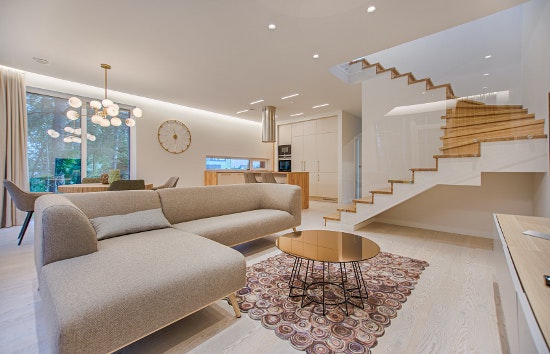Creating a visually pleasing space requires a combination of design elements, including color, texture, lighting, and furniture. By carefully considering each of these elements, you can create a space that looks attractive and feels comfortable and functional.

How to Make Your Space Visually Pleasing:
Color
Color is a powerful tool that instantly transforms a space and sets the mood. It’s important to think about the mood you want to create when picking paint colors. Colors like blue and green may be used to provide a good mood, while colors like yellow and red can inject energy and vitality into a space.
Texture
Texture is very significant since it enriches the visual experience of a space. A mix of tactile textures, like hand-woven rugs and blankets, Mexican tile, and rattan furniture can greatly contribute to the overall look and feel of the space.
Lighting
Lighting is a crucial aspect of visual design and can be used to create a variety of moods and effects. A space may be made to seem more open and spacious by letting in natural light, while artificial lightings like table lamps and pendant lights can be used to draw attention to certain features or to provide a warm and inviting mood.
Furniture
Among the many decorative options available, furniture plays a crucial role in setting the tone for the whole space. When choosing furniture, consider each piece’s size, shape, and style and how it contributes to the overall look and feel of the space. It’s also important to choose furniture that is functional and comfortable, as well as visually pleasing.
Accessories
Accessories, such as decorative pillows, curtains, and artwork, are a great way to add color, texture, and interest to a space. When handpicking accessories, consider how each item contributes to the overall look and feel of the space, and choose items that reflect your style and taste.
Proportion
Proportion refers to the relationship between the size of one object and another and is an important aspect of visual design. When handpicking items, consider each item’s size and how it contributes to the overall look and feel of the space. For example, a large statement piece, such as a sofa or armchair, can be balanced by smaller accessories, such as throw pillows or a table lamp.
Benefits of Making your Space Visually Pleasing:
Making your space visually pleasing has many benefits that can enhance your daily life and overall well-being. Here are a few advantages of creating a visually pleasing environment:
Increased Mood
A visually pleasing environment can lift your mood, reduce stress and anxiety, and help you feel more relaxed.
Enhanced Productivity
A well-designed and visually appealing space can increase motivation and productivity, making it easier to focus and get things done.
Improved Mental Health
A visually pleasing environment can improve your mental health, reduce depression and anxiety, and help you feel more optimistic.
Increased Sense of Calm
A visually soothing space can help you feel more relaxed and peaceful, reducing stress and promoting restful sleep.
Improved Aesthetic
A visually pleasing environment can improve the overall aesthetic of your home, making it more attractive and appealing to you and your guests.
Personal Expression
Creating a visually pleasing environment allows you to express your personal style and creativity, making your space feel more like home.
Increased Enjoyment
A visually pleasing environment can enhance your enjoyment of your home, making it a place where you love to spend time and entertain.
Potential Drawbacks:
Time and Effort
Creating a visually pleasing and unique space can take significant time and effort to plan, execute, and maintain.
Cost
Implementing design elements to make a space visually appealing may come with a high financial cost.
Maintenance
Keeping a visually unique space in good condition requires regular maintenance and cleaning, which can be time-consuming and costly.
Personal Taste
What may be visually pleasing to one person may not be to another, leading to subjective opinions and preferences.
Limited Options
There may be limitations on what can be done in space due to existing structures, regulations, or other constraints.
Conclusion
It carefully considers color, texture, lighting, furniture, accessories, and proportions to create a visually appealing setting. You can create a room that looks lovely and feels comfortable and practical by employing these design components and carefully choosing objects that represent your style and taste.
